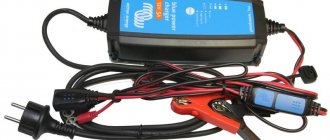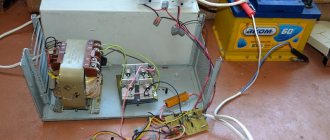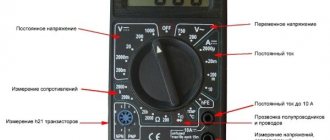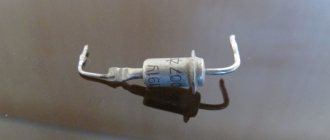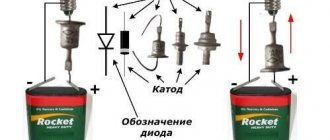Methods for determining capacitance indicators
We will describe the most common ways to check the capacity of a car battery. These 2 methods have proven themselves to be the best and are widely used today.
Long Discharge Method
This method has found its application in laboratory conditions. There are also a household method and a method based on long-term charging. Let's take a closer look at all three:
- Standard method (laboratory). To check, the battery must be charged as much as possible and discharged using a minimum current. At the same time, the amount of time during which the discharge occurs is taken into account. The battery capacity, as described above, is nothing more than the product of time and current strength. The complexity of measurements in this case depends on maintaining a constant current discharge using specialized equipment, which is why the method is laboratory.
- Household method. You can check the battery capacity using a constant load. In this case, they use car lamps, creating a load with their help. By analogy with the first method, the time is calculated in parallel in hours. This procedure has its own error, since the load current gradually decreases and the final result of determining the capacitance is not entirely accurate. It is worth noting that the power source should not be allowed to completely discharge, as this may cause it to fail.
- Method based on long-term charging. In this case, an electronic clock and the electrical circuit to which it is connected are used. The diagram itself can be easily found on the Internet. Measurements are carried out over 20 hours.
Method using an electronic tester
This method compares favorably with others in that it is carried out in a shorter period of time. To carry it out, you will need a special device - a tester, which can simultaneously analyze a series of necessary measurements.
The testers operate automatically and do not require special knowledge from the person taking the measurements. Its operating time takes only 10 – 15 seconds. The device easily connects to a power source and has only one button that starts the capacitance measurement process.
The selection of a battery is made based on a comparison of the residual capacity and the nominal capacity, which is indicated by the manufacturer in the battery passport. The difference should not exceed 50%, otherwise such a power source is not ready for further use.
Multimeter method
This device allows you to measure not only battery capacity, but can also be used as an ohmmeter and voltmeter. Measuring the battery capacity with a multimeter is not difficult if you follow the following steps exactly as they are listed below:
- The device must be switched to continuous measurement mode.
- Next, a range is established that is slightly larger than that stated in the battery passport.
- A special black probe is connected to the socket (-).
- The red probe is connected to the socket (+) in the same way.
- The readings are read and displayed.
- At the end of the measurement procedures, the electrical circuit is disconnected.
This text provided comprehensive answers to questions such as: what is needed in order to measure the battery capacity? How to measure? How to find out or how to determine capacitance indicators? The most popular methods and methods of measurement were described. All this information will be useful to every car enthusiast, because knowledge in this area will help in the future when choosing a specific battery. A charger and these skills will keep your power source in working condition much longer.
Checking battery capacity with a multimeter Electrician
How to check the battery capacity with a multimeter
Each lead-acid battery loses its maximum capacity and performance properties over time; a deposit of lead sulphate salts forms on the plates - sulfation. The amount of acid per percentage of electrolyte becomes less and naturally the density of the electrolyte decreases.
How can I check my battery?
Electrolyte density is the oldest and most popular method, but modern sealed batteries do not have holes for checking in this way. With this method you can only learn a little about the general condition of the battery and its immediate future.
Using a load fork. It is a handle with two probe terminals that last for 1 sec. connected to the battery contacts. The device contains a voltmeter scale and a load that is designed for a certain battery capacity (car battery). The device shows the voltage under load and, depending on the readings of its arrow, one could judge the health of the battery.
A lead-acid battery tester is an electronic device that can show many battery parameters in a few seconds (up to 3 seconds), the main ones being: current, voltage, capacity, forecast for battery life.
Test discharge - well, the drawback is that the battery must be fully charged and its operation (discharge) must be checked for a long time against a known load. This takes a lot of time and wastes battery life.
Checking the battery using improvised means
On some models, an even lower current parameter is indicated (for example, this inscription - Initial current less than - 2.1A) based on this, we take this figure 2.1 * 12 volts = 25 Watt - this is the operating load power of the battery.
Now we need a load average between the operating and half of the maximum capacity, this is approximately 35 Watt, if the operating current is not specified, you can take 40 W. A light bulb (but another similar current load is also possible) of 12 volts is best suited as a load and a power of 35-40 W.
So, we connect the light bulb to the battery terminals for a period of 2 minutes and see if the light bulb changes brightness; if the light dims during this time, then the battery is faulty. If everything is unchanged, then after reaching 2 minutes of illumination, we connect a voltmeter (multimeter) to the glowing light bulb. and look at the voltage:
- more than 12.4 volts - the battery has retained its nominal capacity and is fully operational.
- 12-12.4 volts - the battery is serviceable but already tired
- less than 12 volts - the battery has already lost 50% of its rated capacity and it is better to replace it.
You should be sure that the battery is fully charged; it is best to charge it over the course of a day or at least 6 hours with an appropriate current.
Types of batteries
Depending on the design of the materials used in production, the most common types of rechargeable batteries are:
- Lead-acid - used in cars, motorcycles, mopeds, scooters. They are also used in UPS (uninterruptible power supply systems) and are used to store energy generated by wind generators and solar panels.
- Lithium-ion batteries are small in size, durable and reliable, they are used in mobile phones, photo and video equipment, construction tools, and electric vehicles.
- Nickel-cadmium and nickel-metal hybrid batteries are reliable, durable; such rechargeable batteries have recently been gradually replaced by more compact lithium-ion analogues that are less sensitive to environmental conditions.
Is it possible to check the battery capacity with a multimeter and how to do it? Many people are interested in how to check the battery capacity with a multimeter, and also whether such measurements can be made at all. The answer to these two questions is affirmative - the functionality and accuracy of this meter are sufficient to carry out such operations. How this is done will be discussed in more detail below.
How to measure phone battery capacity programmatically
How to find out the manufacturing date of a battery
If you do not have a tester, you can measure the battery capacity of your smartphone using special applications. One of the best options for this is AccuBattery. The free version of the program has wide functionality and can calculate the operating parameters of the battery. You can download it from Google Play.
To test, install the program on your smartphone, and then discharge it until it turns off. Place your device on charge, turn it on and launch the application. In the "Charging" tab at the bottom, set the design capacity specified by the manufacturer if it is not displayed correctly. Leave the device to charge, preferably up to 100%.
When the smartphone is charged, you can go to the “Health” tab in the program. It displays the current capacity indicator, calculated based on data built into the charge controller in the phone. The program automatically calculates the degree of battery wear and displays it.
AccuBattery
If you keep AccuBattery in the background constantly, the application can generate wear graphs so you can determine how quickly the battery in your phone is degrading.
The downside of AccuBattery, like any analogue, is its high dependence on the accuracy of the smartphone’s on-board sensors. After all, calculations are carried out based on the voltmeter and ammeter readings built into the charge controller. If these sensors are inaccurate and distort information, then the final indicators will be incorrect.
Software methods work worst (or rather, do not work) with cheap Chinese smartphones in the price range of about $100. Such devices, in order to reduce costs, are often deprived of full-fledged sensors. If they exist (and any battery controller on a smartphone’s board can measure voltage and current), then there is no access to these sensors from the operating system. In this case, the program will not be able to measure the phone battery capacity.
In addition to testers and programs, there are more accurate ways to measure battery capacity. There are full-fledged testers for taking measurements on batteries disconnected from the smartphone. These are often used for testing, for example, round batteries of 18650, 14500 and the like formats.
LiitoKala Lii-500
By taking measurements with the battery disconnected from the smartphone, you will get the most accurate capacity readings. But since 90% of modern mobile phones are equipped with non-removable batteries that use a cable for connection instead of a contact pad (as was the case before), this method of measuring capacity is not applicable for them.
What does capacity mean?
Capacity refers to the amount of energy that a battery can store and then deliver to the load. This value is convenient for assessing the condition of the battery and characterizes the level of remaining resource.
Battery capacity decreases over time. This process occurs as a result of chemical reactions, sulfation and destruction of the plates. It can be compared to a decrease in the volume of a vessel due to the adhesion of the substance stored in it to the walls. The degree of reduction of this parameter directly indicates its performance.
Battery capacity is measured in Ampere-hours (Ah). In practice, this means the amount of time a battery is capable of operating at its rated current before being completely discharged. For example, with a capacity of 10 A/h, the battery must continuously deliver a current of 1A for 10 hours or 10A for 1 hour.
What is the capacity of a battery or accumulator
All batteries are usually decorated with inscriptions like 55, 70 Ah or 1800mAh. This designation indicates that the capacity of this battery is, respectively, 55 Amperes or fractions of Amperes per hour, only translated into English - A/hour. It must be distinguished from another parameter - voltage, which is written in Volts.
We advise you to study Corrugated pipe
Standard battery
The Ah indicator shows how long the battery will work for an hour at a load of 60 Amps and a voltage of 12.7V. In other words, capacity is the amount of energy that a battery can hold.
And if there is less than 60A load, the battery will last longer than 60 minutes.
Battery capacity measuring device
Battery capacity is a parameter that determines the amount of energy supplied by the battery at a certain voltage in one hour. It is measured in A/h (Ampere per hour), and depends on which is determined by a special device - a hydrometer. When purchasing a new battery, the manufacturer indicates all technical parameters on the case. But you can determine this value yourself. There are special devices and methods for this.
The easiest way is to take a special tester, for example “Pendant”. This is a modern device for measuring the capacity of a car battery, as well as its voltage. In this case, you will spend a minimum amount of time and get a reliable result. To check, you need to connect the device to the battery terminals and within a few seconds it will determine not only the capacity, but also the battery voltage and the condition of the plates. However, there are other methods for determining battery capacity.
What is a multimeter
It is easy to check battery cells at home with a multimeter. This is a measuring device that can perform several tasks:
- Voltage measurement;
- Current test;
- Resistance measurement;
- Checking diodes, transistors, capacitors
- Frequency measurement.
The convenient thing about this device is that all measurements are carried out by it alone, without the need to have many different meters. In addition, in most cases it is portable, that is, you can measure the parameters of electrical circuits both in the field and at home.
Most multimeters (also called testers) themselves run on batteries.
How to check battery capacity with a multimeter
The battery capacity shows how much current the battery can supply to the load over a certain period of time. Let's take a car battery with a capacity of 60 Ah. Such a battery can supply a current of 60 A to the load for 1 hour, or 6 A for 10 hours. Battery capacity is calculated using the formula: E(A)=I(A)*T(h) where,
E is the battery capacity in Ah, I is the current in amperes, T is the battery discharge time in hours.
One multimeter can determine the capacity of any battery. There are several methods to measure battery capacity.
- Checking the battery capacity with a multimeter.
- Checking the battery charge level with a load plug.
- Checking the battery capacity with a SKAT-T-AUTO tester or similar.
- Checking the battery capacity with an electronic load.
It is possible to determine the battery capacity with one multimeter based on the voltage value. However, this value will be very approximate and not entirely reliable. Using a multimeter and one rheostat, you can more accurately calculate the battery capacity. This calculation will be more complete and reliable.
Checking battery capacity with a multimeter and rheostat
The resistance on the rheostat is set to 2-3 Ohms. Connect it to the battery terminals through a multimeter, which is turned on in the current measurement mode of 10 A of the appropriate polarity, and measure the current through a rheostat. If there is only one multimeter, turn it off, set the operating mode to measure 20 V DC voltage and connect it to the battery terminals.
A rheostat is connected to the same terminals. They note the time and wait several hours until the multimeter shows 12 V. That’s it, the process of measuring the battery charge with a multimeter is completed. Now we multiply the time by the current and find the battery capacity.
A more accurate result can be obtained if you use two multimeters or a multimeter and a 10 A ammeter. In this option, the discharge current is measured every hour and recorded. As the battery discharges, the current will decrease. At the end of the experiment, the average value of the discharge current is found (the currents are summed up and divided by the number of measurements), then the average discharge current is multiplied by the discharge time.
Battery charge level at idle after parking the car for 24 hours
The SKAT-T-AUTO battery capacity tester provides results in 15 - 20 seconds. His readings are not highly accurate, approximate. High accuracy results when measuring battery capacity (at a discharge current of 5A - 1.2%) can be obtained by working with an electronic load.
The electronic load is convenient for use by auto electricians and those who like to experiment with batteries, train them and calculate the exact capacity of the battery. For training, the electronic load is set to a discharge current of 4 - 6 A and a voltage of 12V, upon reaching which the audible alarm for the end of battery discharge is activated.
Electronic load for testing the capacity of all types of batteries
Below 12 V this is already a deep discharge and further discharge is not recommended, since there is a possibility of destruction of the plates. Next, charge the battery with a conventional charger to 14.2 V, after charging the battery, repeat the discharge process again.
At the end of the workout, charge the battery, give 2 hours of rest and measure the battery capacity with an electronic load. To measure capacity in A⋅h mode, set the voltage to 12 V and the discharge current to 4-6 A. A sound alarm will notify you of the end of the process. Next, the battery is charged again and installed on the car. This electronic load tests any 6, 12 and 24 V batteries.
A simple test of battery capacity with a USB tester and subsequent clarification
The USB tester for measuring battery capacity has very rich functionality - it can be used to measure the battery capacity of a tablet, smartphone, or power bank. Based on what this device shows, you can get an idea about the wear of the batteries: is it worth changing the battery, or do you need to purchase a new device.
With just one control button, you can measure various indicators, including the battery capacity of a particular device. The button switches tester memory cells and operating modes. If there is a sufficient voltage level in the connected device, the tester turns on.
The meter usually displays the battery capacity indicator in the lower left corner. The measurement accuracy of the tester is not 100% , and therefore it is recommended to use a simple mathematical formula based on the following example.
Let's say you have a certain device (phone, power bank or tablet), which, being completely discharged, charged in a period of time equal to 3 hours. If, out of curiosity, you measured the current using a tester, and its value was, for example, 1.15 A, the actual battery capacity of your device is calculated by multiplying these two numbers together. 1.15 amperes is 1150 milliamps, multiply this number by 3 and get 3450 mAh. This is how real capacitance is measured. If the current “capacity” on your device indicated by the manufacturer is several times greater than the actual one, this is just a standard advertising ploy that should not be trusted.
How to check your phone's battery capacity with a USB tester
As mentioned above, the easiest way to check your phone's battery capacity is to use a USB tester.
USB Safety Tester J7-T
On one side, such a device contains a USB plug, which is inserted into the power supply, and on the other, a USB socket into which the smartphone is connected with a cable. The device also contains a screen on which testing indicators are displayed.
RD UM24C - advanced smartphone battery tester Rd Tech
There are many types of USB testers: from simple ones for a couple of dollars that can only show volts, amps and count mAh - to advanced professional ones that are tens of times more expensive. The latter are often equipped with color screens, can count watt-hours out of the box, support fast charging, take into account efficiency, can be synchronized with a PC to create graphs, etc. To simply check the battery capacity of your phone, a simple device, like the one in the illustration, is enough.
KCX-017
KCX-017 - budget smartphone battery tester Megadevice
To take measurements, discharge your smartphone to zero. Then connect the tester to the charger, connect your device to the tester with a cable, and leave it to charge to 100%. When the battery is charged, the tester will show how much energy is filled into it.
If the device can display watt hours, this is the amount of energy. To convert it to mAh, divide the resulting number by the voltage of 3.8 volts, and multiply by about 0.9 (since efficiency rarely exceeds 90%). That is, if the device shows 10 watt-hours (10 Wh), then (10/3.8)*0.9=2.37 Ah or 2370 mAh is the battery volume. If the capacity stated in the characteristics of the smartphone is 2500 mAh, then the battery wear is about 5%.
If the USB tester only measures mAh, then you need to make allowances for voltage differences. To do this, first multiply the number of mAh by 5 (volts), and then divide the resulting result (this will be milliwatt hours) by 3.8 and multiply by 0.9.
With tester readings of 4669 mAh, the smartphone battery capacity will be 4669*5=23345 mWh, (23345/3.8)*0.9=5529 mAh. That is, although the device indicated only 4669 mAh, the phone’s battery capacity in the units indicated in the specifications is about 5529 mAh.
Shopper.Life



